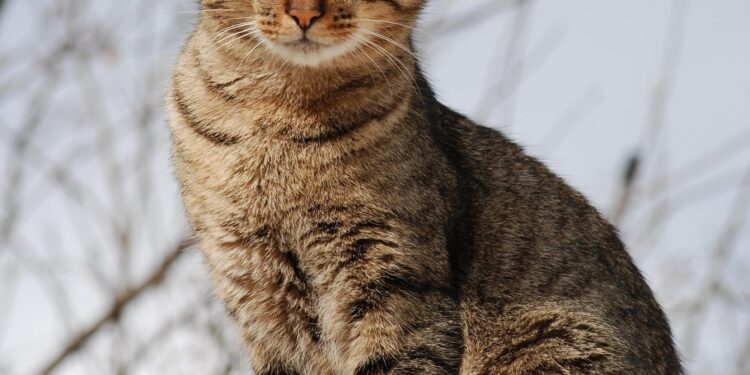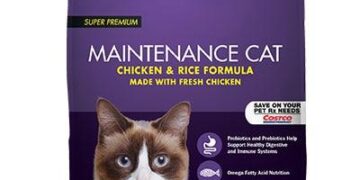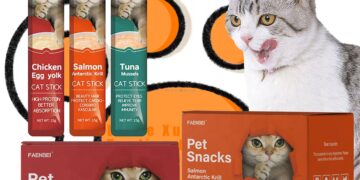Table of Contents
It started with a sound.
The soft, wet thump in the hallway in the middle of the night.
At first, I thought it was a fluke.
But soon, the nightly ritual of finding small, sad puddles of vomit became a grim routine.
Then came the scratching.
Not the casual ear-scratch of a contented cat, but a frantic, incessant, heartbreaking clawing that left my beautiful silver tabby, Leo, with raw, weeping sores around his neck and on his belly.
Our lives became a blur of vet visits.
We ran tests.
We tried medications.
The bills piled up, each one a paper monument to my growing desperation.
I was doing everything “right,” or so I thought.
I was a dedicated, loving cat owner.
I bought the expensive, beautifully packaged “premium” foods from the boutique pet store.
I listened to the advice of the well-meaning staff who pointed me toward formulas with exotic proteins and colorful vegetables.
Yet, Leo was only getting worse.1
His coat grew dull, his energy waned, and the light in his bright green eyes seemed to dim with every miserable, itchy day.
The breaking point came on a Tuesday.
Armed with new advice, I had spent a small fortune on a bag of ultra-premium, “limited ingredient” lamb kibble and a case of the matching wet food.
The label promised simplicity, a pure and gentle solution.
I served it to Leo with a sense of profound hope.
That night, he suffered one of the worst flare-ups I had ever seen.
He vomited three times and scratched himself until he bled, ending in a frantic, late-night trip to the emergency vet.
Sitting in that sterile room, with Leo shivering in his carrier, I felt a crushing wave of failure.
I had followed all the rules, bought all the “best” products, and had only managed to make my beloved cat sicker.
It was then I realized the rules were wrong.
The entire game was rigged, and I was losing.
Part I: The Revolving Door of “Solutions” That Weren’t
My journey down the rabbit hole of feline nutrition began with a single, burning question: Why did all the “solutions” fail? I spent weeks poring over veterinary journals, nutrition papers, and forum posts from other desperate owners.4
What I discovered was a landscape of marketing myths and half-truths designed to sell products, not solve complex medical problems.
I had been trapped in a revolving door of expensive failures, and it was time to understand why.
The “Limited Ingredient” Lie
My first major discovery was the most shocking.
The term “Limited Ingredient Diet” or “LID,” which had been my beacon of hope, was essentially meaningless.
I learned that the term is not regulated by the FDA or AAFCO (the Association of American Feed Control Officials).7
A company can write “limited ingredient” on the label of any cat food, regardless of how many ingredients it actually contains.
The promise of simplicity that had so appealed to my desperate mind was, in reality, just a marketing slogan.8
But the problem runs deeper than just a loose definition.
Even if a brand genuinely tries to create a simple formula, the realities of mass production create a huge risk of cross-contamination.
A factory that produces a dozen different formulas—one with chicken, one with fish, one with beef—can have trace amounts of those proteins end up in the “limited ingredient” duck formula processed on the same equipment.10
For a highly sensitive cat like Leo, a few molecules of an offending protein are all it takes to trigger a full-blown reaction.
This led me to a frustrating realization.
The very tool I was using to simplify the problem was actually making it more complex.
I was trying to isolate a single variable—the protein source—but the unregulated nature of the term and the high probability of hidden contaminants meant I was unknowingly dealing with dozens of uncontrolled variables.
Every time a food failed, I didn’t know if Leo was allergic to the main protein, or to a hidden contaminant.
This “paradox of simplicity” kept me stuck in a cycle of buying, trying, and failing, getting no closer to a real diagnosis while my cat continued to suffer.
The simple-sounding solution was actively preventing me from finding the real answer.
Chasing the Grain-Free Ghost
Like many conscientious pet owners, I had been thoroughly convinced that grains were the enemy.
The marketing is pervasive and effective: “ancestral diets,” “species-appropriate,” “no fillers.” I meticulously scanned every label, ensuring not a speck of corn, wheat, or soy passed Leo’s lips.12
I swapped these for foods heavy in potatoes, peas, and lentils, feeling confident that I was making a healthier choice.
Yet, Leo’s itching and vomiting persisted without change.
The truth, as I found in numerous veterinary and nutritional sources, is that true grain allergies in cats are exceedingly rare.7
The vast majority of feline food allergies are reactions to the animal protein in the food.
The most common culprits are, ironically, the most common ingredients in cat food: beef, fish, and chicken.1
While a small number of cats may have issues with grains, they are not the widespread villains that marketing departments would have us believe.
This was a profound lesson in how marketing can misdirect our best intentions.
The “grain-free” movement is a brilliant piece of commercial storytelling.
It taps into our human dietary trends (like paleo and gluten-free) and our desire to feed our pets something “natural”.8
By focusing all our attention on the statistically insignificant threat of grains, pet food companies create a powerful red herring.
It distracts us from the real problem—the protein source—while selling a premium-priced product.
I had spent years chasing the grain-free ghost, feeling like I was making a healthy choice for Leo, all while continuing to feed him different forms of the very proteins that were making him sick.
The marketing had successfully made a sale, but it had completely failed my cat.
Part II: The Epiphany: It’s Not a Shopping Problem, It’s an Investigation
Defeated and armed with a dangerous amount of scattered information, I booked a consultation with a board-certified veterinary nutritionist.
I walked in with a binder full of notes, ingredient lists, and a heavy heart.
I laid out Leo’s entire history: the vomiting, the scratching, the endless parade of expensive, failed foods.
She listened patiently, nodding as I recounted my frustrating journey.
When I finished, she didn’t point me to another “miracle” food.
Instead, she gave me a piece of advice that changed everything.
“Stop thinking like a shopper,” she said gently.
“You’ve been trying to find a magic can on a shelf, hoping it will be the one.
I want you to start thinking like a forensic investigator trying to identify a suspect in a complex case.”
The analogy struck me like a lightning bolt.
A shopper is passive; they browse and hope.
An investigator is active; they follow a strict, methodical process to uncover the truth.
A shopper can be fooled by fancy packaging and clever marketing.
An investigator trusts only hard evidence and reliable tools.14
This single shift in perspective gave me a new framework, a new way to see the problem.
My mission was no longer to buy a solution, but to conduct an investigation to find one.
This “Cat Food Detective” mindset was built on three core principles that would guide every decision I made from that point forward:
- You cannot identify the culprit if the crime scene is contaminated. My kitchen had been a contaminated scene for years, filled with uncontrolled variables from treats, cross-contaminated foods, and well-meaning guesses.
- You must use reliable, specialized tools to analyze the evidence. The over-the-counter foods I had been using were like unreliable informants. For a real investigation, I needed professional, forensic-grade tools.
- You must follow a strict, methodical procedure. Guesswork and random trials had to be replaced with a disciplined, step-by-step process designed to eliminate variables and reveal the truth.
For the first time in years, I felt a sense of control.
I wasn’t just a frustrated consumer anymore.
I was an investigator, and I finally had a case to solve.
Part III: The Forensic Toolkit: Your Step-by-Step Investigation Plan
Armed with my new mission, the veterinary nutritionist walked me through the official “investigative protocol” for diagnosing a feline food allergy.
This wasn’t a quick fix; it was a rigorous, scientific process.
But it was also the only path to a definitive answer.
Securing the Scene: The Elimination Diet Trial
The first and most critical step was to “secure the crime scene.” In the world of veterinary medicine, this is called the Elimination Diet Trial, and it is the undisputed gold standard for diagnosing food allergies.1
Blood and saliva tests for food allergies are considered unreliable; this is the only way to get a real answer.17
The protocol is deceptively simple, but its success hinges on absolute, non-negotiable adherence.
For a period of 8 to 12 weeks, the cat must eat absolutely nothing except a specially selected prescription food and water.
Nothing.
This means:
- No treats, no matter how much they beg.
- No table scraps or tidbits from your plate.
- No flavored medications, supplements, or dental chews.
- No access to other pets’ food bowls.
- No hunting outdoors.
- No licking plates in the dishwasher or scavenging from the trash.10
This creates a “clean” environment where, if the symptoms resolve, we can be confident it was due to the dietary change.
The nutritionist warned me that it takes time.
Gastrointestinal issues like vomiting and diarrhea might improve within a few weeks, but skin-related symptoms—the deep, maddening itch—can take 8 weeks or even longer to fully resolve as the body heals and grows new, healthy skin cells.20
This was a marathon, not a sprint.
The Two Lead Detectives: Novel vs. Hydrolyzed Proteins
For a true elimination trial, you can’t use an over-the-counter food from the pet store.
The risk of cross-contamination is simply too high to guarantee a “clean” test.18
Instead, you must use one of two types of specialized, prescription therapeutic diets.
The nutritionist presented them to me as my two lead detectives, each with a different strategy for cracking the case.
1. The “Avoidance” Detective: Novel Protein Diets
A novel protein diet is built around a protein source that your cat’s immune system has, ideally, never encountered before.13 Since an allergy is an immune overreaction to a familiar substance, introducing something entirely new bypasses the trigger.
Common novel proteins include rabbit, duck, venison, and even kangaroo.13
- Advantages: These diets are often more palatable to cats and can be slightly less expensive than their hydrolyzed counterparts.23
- Disadvantages: Their success depends entirely on the protein being truly novel. This requires a perfect and complete dietary history of your cat. If you forgot about a treat you gave them years ago that contained duck, a duck-based diet trial will fail.23
2. The “Disguise” Detective: Hydrolyzed Protein Diets
A hydrolyzed protein diet takes a different approach.
Instead of avoiding a common allergen like chicken, it takes the chicken protein and uses enzymes to break it down into microscopic pieces (a process called hydrolysis).11 These protein fragments are so small that the cat’s immune system no longer recognizes them as the “chicken” it’s trained to attack, rendering them immunologically invisible.26
- Advantages: This is an incredibly effective tool for cats who have been exposed to a wide variety of foods, making it nearly impossible to find a truly novel protein. It takes the guesswork out of the equation.11
- Disadvantages: These diets are typically more expensive. The hydrolysis process can alter the taste, making them less palatable for some picky cats, and in some cases, the change in molecular size (osmolarity) can lead to temporary digestive upset like loose stools.23
The choice between these two “detectives” is a strategic one, based on the specific “case file” of the cat.
For a cat with a very limited and well-documented diet history, a novel protein diet is an excellent and logical first step.
But for a cat like Leo, who had tried countless foods and treats over the years, the hydrolyzed diet was the forensically “safer” option.
It eliminated the risk of me misremembering his entire dietary history and increased the odds of a successful trial on the first attempt, ultimately saving time, money, and further frustration.11
Analyzing the Evidence: How to Read a Cat Food Label
The final part of my “detective training” was learning to analyze evidence—to see a cat food label not as a collection of marketing claims, but as a technical report.
This skill is crucial for both the trial and for long-term management.
- The Ingredient List is Your Witness Statement: The ingredients are listed by weight, so the first few items make up the bulk of the food.27 For a limited ingredient diet, you want to see a single, clearly named animal protein source (e.g., “Deboned Duck,” not “Meat By-Products”) at the very top.28 Then, scan the entire list for hidden allergens. It’s shocking how many “Duck Recipe” foods also contain chicken fat or fish oil, either of which could be the true culprit.
- Deconstructing the “Guaranteed Analysis”: The percentages for protein, fat, and fiber on the can are listed on an “as-fed” basis, which includes all the moisture. This makes it impossible to compare a wet food (which is ~78% water) to a dry food (~10% water). To get a true, apples-to-apples comparison, you must calculate the Dry Matter Basis (DMB).
It sounds complicated, but the formula is simple:
- Find the moisture percentage on the can (e.g., 78%).
- Subtract that from 100 to get the total dry matter (e.g., 100%−78%=22%).
- Take the protein percentage from the label (e.g., 9%) and divide it by the total dry matter (22%).
- Multiply by 100 to get the DMB percentage (e.g., (9/22)×100≈41%).
So, a can that says “9% protein” is actually 41% protein on a dry matter basis.
This calculation is a powerful tool that cuts through the marketing fog and reveals the true nutritional composition of the food.
You’ll often find that many so-called “high-protein, limited ingredient” foods are surprisingly high in carbohydrates once you do the Math.29
Part IV: The Final Report: Case-Winning Limited Ingredient Wet Cat Foods
After completing our strict, 10-week elimination trial on a hydrolyzed diet, Leo’s symptoms vanished.
The vomiting stopped.
The frantic scratching ceased.
For the first time in years, the sores on his belly healed and fine, soft fur began to grow back.
We had our answer: Leo had a severe food allergy.
The next step was the “challenge”—reintroducing single ingredients to pinpoint the exact culprit.
As suspected from his history, the moment we introduced a tiny amount of plain, cooked chicken, the itching returned within 48 hours.
Case closed.
The culprit was chicken.
Now, we could move from the diagnostic phase to the long-term management phase.
This meant finding high-quality, commercially available wet foods that were strictly free of chicken and other potential triggers.
The following products are the result of my exhaustive investigation, categorized by their best “forensic” use-case.
For the Initial Investigation (Prescription Elimination Diets)
These are the “official forensic kits” from your veterinarian.
They are the most reliable tools for getting a definitive diagnosis during an elimination trial.
They are manufactured with the strictest quality control protocols to prevent cross-contamination, which is why they are essential for the diagnostic phase.7
- Hill’s Prescription Diet z/d Skin/Food Sensitivities: This was a key tool in our investigation. Its primary protein is hydrolyzed chicken, making it an excellent example of the “disguise” strategy. Because it comes in a wet pâté form, it’s a fantastic option for cats who need the hydration of wet food.25 User experiences frequently confirm its effectiveness for cats with severe allergies and digestive issues, often resolving chronic problems when other foods have failed.4
- Royal Canin Veterinary Diet Hydrolyzed Protein Adult HP: This is another top-tier prescription diet, but it uses hydrolyzed soy as its protein source.25 It is highly regarded for its ability to manage both dermatological and gastrointestinal issues, with many owners reporting it resolved chronic vomiting and IBD symptoms.35 A significant consideration is that this specific formula is typically only available as a dry kibble. While water can be added to soften it, it does not come in a dedicated wet food format, which can be a drawback for cats needing maximum hydration.37
For Post-Trial Management (Best-in-Class OTC Novel Protein Diets)
Once you have identified the specific allergen(s) and “closed the case,” you can often transition to a high-quality over-the-counter (OTC) food for long-term management.
The key is to apply your new “detective” skills to find a truly limited-ingredient, single-protein formula from a reputable brand.
The following are excellent options, each with its own unique profile.
- Merrick Limited Ingredient Diet (Real Turkey Pâté): This is a strong, accessible choice. Turkey is a novel protein for many cats, and this formula uses it as a single protein source with a relatively low carbohydrate load.29 Crucially for many sensitive cats, it contains no fish oil, which can be a hidden allergen.38 Reviews often praise its palatability and its success in helping cats with allergies and IBD.38 However, some users have noted inconsistencies in texture from batch to batch, and the inclusion of guar gum may cause loose stools in very sensitive individuals.29
- Ziwi Peak (Lamb Recipe): This is an ultra-premium food for the discerning carnivore. It features a single novel protein (grass-fed lamb) and is packed with a species-appropriate blend of muscle meat, organs, and bone, closely mimicking a natural prey diet.29 It’s a fantastic option for cats needing high protein and fat. The main flags are its very high price point and the inclusion of chickpeas as a binder, which elevates the carbohydrate content slightly and may not be suitable for the small number of cats sensitive to legumes.40
- Natural Balance L.I.D. (Duck & Green Pea Formula): This is a widely available and more budget-friendly option that has been a lifesaver for many owners. Duck serves as a reliable novel protein for cats with chicken or beef allergies.42 There are numerous success stories from owners managing cats with IBD, pancreatitis, and severe allergies who thrive on this food.42 The primary drawbacks are a higher carbohydrate content compared to premium brands like Ziwi Peak, and some users have reported significant inconsistencies in the wet food’s texture, with some batches being overly “soupy”.31
- Blue Buffalo Basics (Duck & Potato Pâté): Another very accessible option that explicitly avoids multiple common allergens. It uses duck as a single animal protein source and is formulated to be free of chicken, beef, dairy, and eggs.46 Many reviewers report success in managing their cats’ IBS and skin allergies with this food, and it’s often praised for its palatability.48 On the other hand, the brand has a mixed reputation among some veterinary professionals, and even its “limited” formulas can have a longer ingredient list than competitors, including various fruits and vegetables that add complexity.49
The Cat Food Detective’s Evidence Locker
To help you compare these top suspects, I’ve compiled their key data into a single evidence file.
This allows for a direct, “forensic” comparison based on facts, not just marketing.
| Product Name | Primary Protein | Protein Type | Key Features & Potential Flags | Dry Matter Protein % | Dry Matter Fat % | Dry Matter Carb % | Investigative Use-Case |
| Hill’s Prescription Diet z/d | Hydrolyzed Chicken | Hydrolyzed | Features: Gold standard for diagnosis, wet pâté available. Flags: Requires vet prescription, expensive. | 38.6% | 22.7% | 29.5% | Diagnosis: The primary tool for a definitive elimination diet trial, especially for cats with complex dietary histories. |
| Merrick LID Turkey Pâté | Turkey | Novel | Features: Single protein, no fish oil, low carb. Flags: Guar gum may affect some cats, texture can be inconsistent. | 40.9% | 22.7% | 16.4% | Management: Excellent post-diagnosis option for cats with confirmed chicken/beef/fish allergies. |
| Ziwi Peak Lamb Recipe | Lamb | Novel | Features: Ultra-premium, species-appropriate (meat, organs, bone). Flags: Very expensive, contains chickpeas. | 43.2% | 27.3% | 6.8% | Management: Top-tier choice for owners prioritizing ingredient quality and low carbs for confirmed non-lamb allergies. |
| Natural Balance LID Duck & Pea | Duck | Novel | Features: Widely available, affordable, good for IBD. Flags: Higher carb content, inconsistent texture reported. | 40.9% | 31.8% | 18.2% | Management: A reliable and accessible workhorse for cats with common protein allergies who tolerate peas well. |
| Blue Buffalo Basics Duck & Potato | Duck | Novel | Features: Explicitly free of chicken/beef/dairy/eggs. Flags: Longer ingredient list than other LIDs, mixed brand reputation. | 34.1% | 27.3% | 25.0% | Management: A good starting point for owners suspecting a chicken or beef allergy and looking for an easily sourced option. |
Note: Dry Matter Basis (DMB) percentages are calculated based on Guaranteed Analysis data from product labels and reviews.29
These values can vary slightly between batches.
Conclusion: Case Closed—Our New Life of Health and Peace
Today, Leo is a different cat.
His coat is thick and glossy, his energy is boundless, and his days are filled with playful pounces and contented purrs, not frantic scratching.
The nightly sound of vomiting has been replaced by the gentle rhythm of his happy breathing as he sleeps at the foot of my bed.
The case of his mysterious illness is officially closed.
Our solution was to adopt the “Cat Food Detective” mindset for life.
After identifying his severe chicken allergy, we built a rotational diet for him based on high-quality, single-protein wet foods, primarily duck and rabbit.
We read every label, every time.
We introduced new foods slowly and methodically.
We became investigators of his well-being.
The journey was long and, at times, deeply frustrating.
But the epiphany that changed everything was realizing that I wasn’t looking for the “best cat food” on the market.
I was looking for the best process to discover the right food for my individual cat.
The answer wasn’t on a pet store shelf; it was in the methodical, evidence-based approach recommended by veterinary science.
If you are standing where I once stood—worried, frustrated, and watching your beloved cat suffer—I hope this story gives you a new sense of hope and empowerment.
Put away the shopper’s mindset of guesswork and random trials.
Become a detective.
Secure the scene with a strict elimination diet.
Use the right forensic tools—a novel or hydrolyzed protein diet—in partnership with your veterinarian.
Analyze the evidence on every label.
By following the process, you can solve this mystery.
You can close the case and give your cat the gift of a healthy, peaceful, and itch-free life.
Works cited
- The Most Common Food Allergies in Cats | Avon Vets – Animal General, accessed August 17, 2025, https://www.animalgeneralct.com/site/blog/2024/02/15/most-common-food-allergies-cats
- Cat Diseases – Allergy and Food Intolerance – Hill’s Pet Nutrition, accessed August 17, 2025, https://www.hillspet.com/cat-care/healthcare/cat-food-allergies-and-intolerance
- My cat Tessa, her severe allergies and Atopica | – Misti Layne Photography, accessed August 17, 2025, https://www.mistilayne.com/severe-cat-allergies-atopica/
- Experiences with food allergy : r/catfood – Reddit, accessed August 17, 2025, https://www.reddit.com/r/catfood/comments/1b6ehev/experiences_with_food_allergy/
- cats with food allergy experiences : r/CatAdvice – Reddit, accessed August 17, 2025, https://www.reddit.com/r/CatAdvice/comments/yi8x4e/cats_with_food_allergy_experiences/
- Cat has allergies, don’t know what to do – Cat Chat Feline Forum, accessed August 17, 2025, https://www.catchat.org/felineforum/viewtopic.php?t=486
- Limited Ingredient Cat Food: Is It Better? – PetMD, accessed August 17, 2025, https://www.petmd.com/cat/nutrition/what-limited-ingredient-cat-food
- The Truth Behind Pet Food Labels – The Cat Care Clinic Veterinary …, accessed August 17, 2025, https://catcare.com/blog/the-truth-behind-pet-food-labels/
- Pet Food Marketing Hype | Little Big Cat – Dr. Jean Hofve, accessed August 17, 2025, https://littlebigcat.com/pet-food-marketing-hype/
- Food Allergies in Cats: Does My Cat Have Food Allergies? – MedVet, accessed August 17, 2025, https://www.medvet.com/food-allergy-cat/
- Hydrolyzed Diets – NC State Veterinary Hospital, accessed August 17, 2025, https://hospital.cvm.ncsu.edu/services/small-animals/nutrition/hydrolyzed-diets/
- Grain-Free Cat Foods: Getting the facts right, accessed August 17, 2025, https://www.acatclinic.us/grain-free-cat-foods/
- Food Allergies | Cornell University College of Veterinary Medicine, accessed August 17, 2025, https://www.vet.cornell.edu/departments-centers-and-institutes/cornell-feline-health-center/health-information/feline-health-topics/food-allergies
- Analogical problem-solving – (Intro to Brain and Behavior) – Fiveable, accessed August 17, 2025, https://library.fiveable.me/key-terms/introduction-brain-behavior/analogical-problem-solving
- Analogical Thinking in Problem-Solving and Creativity (Chapter 5) – Cambridge University Press, accessed August 17, 2025, https://www.cambridge.org/core/books/rethinking-creativity/analogical-thinking-in-problemsolving-and-creativity/0B0E49277F5608EEA7FBF7185C057B86
- Managing Food Allergies with an Elimination Diet – Animal Kingdom Veterinary Hospital, accessed August 17, 2025, https://animalkingdomvet.net/blog/managing-food-allergies-with-an-elimination-diet/
- Identifying food allergies: The veterinary elimination diet trial – DVM360, accessed August 17, 2025, https://www.dvm360.com/view/identifying-food-allergies-veterinary-elimination-diet-trial
- Implementing an Elimination-Challenge Diet Trial Cat | VCA Animal Hospitals, accessed August 17, 2025, https://vcahospitals.com/know-your-pet/implementing-an-elimination-challenge-diet-trial-cat
- FOOD TRIAL INSTRUCTIONS FOR CATS – Nextmune UK Laboratories, accessed August 17, 2025, https://nextmunelaboratories.co.uk/wp-content/uploads/2020/04/Feline-Food-Trial-Instructions.pdf
- Diet Elimination Trials | Purina Institute, accessed August 17, 2025, https://www.purinainstitute.com/centresquare/therapeutic-nutrition/diet-elimination-trials
- Cat Elimination Diet | 5Strands, accessed August 17, 2025, https://www.5strands.com/blogs/news/cat-elimination-diet
- Diet Elimination Trial How To at Home for Dogs and Cats – Lifetime Pet Center, accessed August 17, 2025, https://lifetimepetcenters.com/blog/984536-diet-elimination-trials-how-to
- Food Allergy: Diagnostics & Therapeutic Food Options | Today’s …, accessed August 17, 2025, https://todaysveterinarypractice.com/nutrition/food-allergy-diagnostics-therapeutic-food-options/
- Elimination diet for dogs and cats – Karlsruhe Veterinarian – Arndt Small Animal Center, accessed August 17, 2025, https://tierarzt-karlsruhe-durlach.de/en/elimination-diet-for-dogs-and-cats/
- What Is Hydrolyzed Protein Cat Food? And Is It Right for Your Cat? – PetMD, accessed August 17, 2025, https://www.petmd.com/cat/nutrition/hydrolyzed-protein-cat-food
- Hydrolysed Protein Diets – WSAVA2013 – VIN, accessed August 17, 2025, https://www.vin.com/apputil/content/defaultadv1.aspx?id=5709749&pid=11372
- The Ultimate Guide to Choosing the Right Cat Food for Your Feline Friend – Vital Essentials, accessed August 17, 2025, https://www.vitalessentials.com/raw-guide/the-ultimate-guide-to-choosing-the-right-cat-food-for-your-feline-friend
- 5 Cat Food Ingredients to Look For & Ones to Avoid | The Vets, accessed August 17, 2025, https://thevets.com/resources/pet-nutrition/cat-food-ingredients/
- What’s Best Limited Ingredient Cat Food? We Tested 10 Recipes – Cats.com, accessed August 17, 2025, https://cats.com/best-limited-ingredient-cat-food
- Unbiased Merrick Cat Food Review – Cats.com, accessed August 17, 2025, https://cats.com/merrick-cat-food-review
- Unbiased Natural Balance Cat Food Review – Cats.com, accessed August 17, 2025, https://cats.com/natural-balance-cat-food-review
- Top 5 Hypoallergenic Cat Food You Should Try, accessed August 17, 2025, https://purrfectgrooming.pet/blog/b/top-hypoallergenic-cat-food-you-should-try/
- Wet Cat Food For Cats With Allergies – Petco, accessed August 17, 2025, https://www.petco.com/shop/en/petcostore/o/wet-cat-food-for-cats-with-allergies
- Feline Hydrolyzed Protein HP | Royal Canin US, accessed August 17, 2025, https://www.royalcanin.com/us/cats/products/vet-products/hydrolyzed-protein-hp-3902
- Feline Hydrolyzed Protein HP | Royal Canin US, accessed August 17, 2025, https://www.royalcanin.com/us/cats/products/vet-products/hydrolyzed-protein-hp-3902?bvstate=pg:4/ct:r
- Feline Hydrolyzed Protein HP | Royal Canin US, accessed August 17, 2025, https://www.royalcanin.com/us/cats/products/vet-products/hydrolyzed-protein-hp-3902?bvstate=pg:9/ct:r
- ROYAL CANIN VETERINARY DIET Adult Hydrolyzed Protein HP Dry Cat Food, 12-oz bag, accessed August 17, 2025, https://www.chewy.com/royal-canin-veterinary-diet-adult/dp/35479
- Product Reviews for MERRICK Limited Ingredient Diet Grain-Free Real Turkey Pate Recipe Canned Cat Food – Chewy.com, accessed August 17, 2025, https://www.chewy.com/merrick-limited-ingredient-diet-grain/product-reviews/115597
- Limited Ingredient Grain Free Turkey Wet Cat Food | Merrick Pet Care, accessed August 17, 2025, https://www.merrickpetcare.com/shop/limited-ingredient-diet-grain-free-turkey-wet-cat-food?bvstate=pg:2/ct:r
- Unbiased Ziwi Peak Cat Food Review – Cats.com, accessed August 17, 2025, https://cats.com/ziwi-peak-cat-food-review
- Thoughts on Ziwi Peak? : r/catfood – Reddit, accessed August 17, 2025, https://www.reddit.com/r/catfood/comments/1laqoqk/thoughts_on_ziwi_peak/
- Natural Balance Limited Ingredient Diets Cat Food – Grain Free, Duck & Green Pea, accessed August 17, 2025, https://www.petsmart.com/cat/food-and-treats/wet-food/natural-balance-limited-ingredient-diets-cat-food–grain-free-duck-and-green-pea-30411.html
- NATURAL BALANCE Limited Ingredient Reserve Duck & Green Pea Recipe Wet Cat Food, 5.5-oz can, case of 24 – Chewy.com, accessed August 17, 2025, https://www.chewy.com/natural-balance-limited-ingredient/dp/29433
- Natural Balance Limited Ingredient Reserve Grain Free Duck & Green Pea Recipe Dry Cat Food | Pet Supermarket, accessed August 17, 2025, https://www.petsupermarket.com/cat/food-treats/dry-food/natural-balance-reserve-limited-ingredient-grain-free-duck-green-pea-recipe-dry-cat-food/FCM00112.html
- Product Reviews for NATURAL BALANCE Limited Ingredient Reserve Duck & Green Pea Recipe Wet Cat Food – Chewy, accessed August 17, 2025, https://www.chewy.com/natural-balance-limited-ingredient/product-reviews/29433
- BLUE Basics™ Wet Cat Food Grain-Free (Indoor) – Duck & Potato | Blue Buffalo, accessed August 17, 2025, https://www.bluebuffalo.com/wet-cat-food/basics/grain-free-indoor-duck-potato/
- BLUE BUFFALO Basics Skin & Stomach Care Grain-Free Duck & Potato Entree Indoor Adult Canned Cat Food, 3-oz, case of 24 – Chewy, accessed August 17, 2025, https://www.chewy.com/blue-buffalo-basics-skin-stomach-care/dp/36873
- Blue Buffalo Basics Adult Wet Cat Food – Natural, 3 Oz. – PetSmart, accessed August 17, 2025, https://www.petsmart.com/cat/food-and-treats/wet-food/blue-buffalo-basics-adult-wet-cat-food—natural-3-oz-789.html
- Is Blue Buffalo Blue Basics a good choice for cats with IBD?, accessed August 17, 2025, https://cats.com/community/nutrition/is-blue-buffalo-blue-basics-a-good-choice-for-cats-with-ibd
- Reviews on Blue Buffalo Tastefuls? : r/catfood – Reddit, accessed August 17, 2025, https://www.reddit.com/r/catfood/comments/1jsgawx/reviews_on_blue_buffalo_tastefuls/






